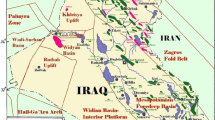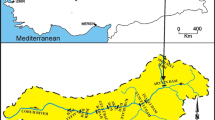Abstract
Static Young’s modulus (Es) is one of the leading mechanical rock properties. The Es can be measured from experimental lab methods. However, these methods are costly, time-consuming, and challenging to collect samples. Thus, some researchers have proposed alternative techniques, such as empirical correlations, to determine the Es. However, the previous studies have limitations: lack of accuracy, the need for specific data, and improper validation to prove the proper relationships between the inputs and outputs to show the correct physical behavior. In addition, most previous models were based on the dynamic Young’s modulus. Therefore, this study aims to use the Gaussian process regression (GPR) method for Es determination using 1853 real global datasets. The utilization of global data to develop the Es prediction model is unique. The GPR model was validated by applying trend analysis to show that the correct relationships between the inputs and output are attained. Furthermore, different statistical error analyses, namely an average absolute percentage relative error (AAPRE), were performed to assess the GPR accuracy compared to current methods. This study confirmed that the GPR model has robustly and accurately predicted the Es with AAPRE of 5.41%, surpassing all the existing studied models that have AAPRE of more than 10%. The trend analysis results indicated that the GPR model follows the proper physical behaviors for all input trends. The GPR model can accurately predict the Es at different ranges of inputs.















Similar content being viewed by others
Data availability
The datasets generated during and/or analyzed during the current study are available from the corresponding author on reasonable request.
Abbreviations
- E s :
-
Static Young’s modulus
- E d :
-
Dynamic Young’s modulus
- GPR:
-
Gaussian process regression
- AVO:
-
Amplitude variations with offset
- RHOB:
-
Bulk formation density
- DTs:
-
Shear time
- DTc:
-
Compressional time
- IQR:
-
Interquartile range
- CF:
-
Covariance function
- T analysis :
-
Trend analysis
- APRE:
-
Average percent relative error
- AAPRE:
-
Average absolute percent relative error
- R :
-
Correlation coefficient
- RMSE:
-
Root mean square error
- SD:
-
Standard deviation
- \(E_{\max .}\) :
-
Maximum absolute percent relative error
- \(E_{\min .}\) :
-
Minimum absolute percent relative error
References
Sebastian HM, Gil IR, Graff MC, Wampler J, Merletti G, Sun T, Patel H, Spain D, Cadwallader S, Cawiezel K et al (2015) 3-D hydraulic fracturing and reservoir flow modeling—key to the successful implementation of a geo-engineered completion optimization program in the Eagle Ford Shale. In: Proceedings of the SPE/AAPG/SEG unconventional resources technology conference. American Association of Petroleum Geologists, Tulsa
Abdulraheem A, Ahmed M, Vantala A, Parvez T (2009) Prediction of rock mechanical parameters for hydrocarbon reservoirs using different artificial intelligence techniques. In: Proceedings of the SPE Saudi Arabia section technical symposium. Society of Petroleum Engineers
Szczepanik Z, Milne D, Hawkes C (2007) The confining effect of end roughness on unconfined compressive strength. In: Proceedings of the 1st Canada-US rock mechanics symposium. American Rock Mechanics Association
Pigott JD, Shrestha RK, Warwick RA (1989) Young’s modulus from AVO inversion. In: SEG technical program expanded abstracts 1989. Society of Exploration Geophysicists, pp. 832–835. ISBN 1052-3812
Potter CC, Foltinek DS (1997) Formation elastic parameters by deriving S-wave velocity logs. CREWES Rep 9:10–23
Kotsanis D, Nomikos P, Rozos D (2021) Comparison of static and dynamic Young’s modulus of prasinites. Mater Proc 5:54
Heerden WL (1987) General relations between static and dynamic moduli of rocks. Int J Rock Mech Min Sci Geomech Abstr 24:381–385. https://doi.org/10.1016/0148-9062(87)92262-5
Christaras B, Auger F, Mosse E (1994) Determination of the moduli of elasticity of rocks. Comparison of the ultrasonic velocity and mechanical resonance frequency methods with direct static methods. Mater Struct 27:222–228. https://doi.org/10.1007/BF02473036
Lacy LL (1997) Dynamic rock mechanics testing for optimized fracture designs. In: Proceedings of the SPE annual technical conference and exhibition. Society of Petroleum Engineers
Bradford IDR, Fuller J, Thompson PJ, Walsgrove TR (1998) Benefits of assessing the solids production risk in a North Sea Reservoir using elastoplastic modelling. In: Proceedings of the SPE/ISRM rock mechanics in petroleum engineering. Society of Petroleum Engineers
Wang Z (2000) Seismic and acoustic velocities in reservoir rocks. Recent Dev Geophys Repr Ser 19:8–23
Wang Z, Nur A (2000) Dynamic versus static elastic properties of reservoir rocks. Seism Acoust Veloc Reserv Rocks 3:531–539
Canady W (2011) A method for full-range Young’s modulus correction. In: Proceedings of the North American unconventional gas conference and exhibition. Society of Petroleum Engineers
Fei W, Huiyuan B, Jun Y, Yonghao Z (2016) Correlation of dynamic and static elastic parameters of rock. Electron J Geotech Eng 21:1551–1560
Mahmoud M, Elkatatny S, Ramadan E, Abdulraheem A (2016) Development of lithology-based static Young’s modulus correlations from log data based on data clustering technique. J Pet Sci Eng 146:10–20. https://doi.org/10.1016/j.petrol.2016.04.011
Davarpanah SM, Ván P, Vásárhelyi B (2020) Investigation of the relationship between dynamic and static deformation moduli of rocks. Geomech Geophys Geo-Energy Geo-Resources 6:29. https://doi.org/10.1007/s40948-020-00155-z
Garaga A, Latha GM (2010) Intelligent prediction of the stress–strain response of intact and jointed rocks. Comput Geotech 37:629–637
Bhatnagar A, Khandelwal M (2012) An intelligent approach to evaluate drilling performance. Neural Comput Appl 21:763–770
Mishra DA, Basu A (2013) Estimation of uniaxial compressive strength of rock materials by index tests using regression analysis and fuzzy inference system. Eng Geol 160:54–68
Kaunda RB, Asbury B (2016) Prediction of rock brittleness using nondestructive methods for hard rock tunneling. J Rock Mech Geotech Eng 8:533–540
Karimpouli S, Fattahi H (2018) Estimation of P-and S-wave impedances using Bayesian inversion and adaptive neuro-fuzzy inference system from a carbonate reservoir in Iran. Neural Comput Appl 29:1059–1072
Jahed Armaghani D, Safari V, Fahimifar A, Monjezi M, Mohammadi MA (2018) Uniaxial compressive strength prediction through a new technique based on gene expression programming. Neural Comput Appl 30:3523–3532
Elkatatny S, Tariq Z, Mahmoud M, Abdulraheem A, Mohamed I (2019) An integrated approach for estimating static Young’s modulus using artificial intelligence tools. Neural Comput Appl 31:4123–4135
Gowida A, Elkatatny S, Gamal H (2021) Unconfined compressive strength (UCS) prediction in real-time while drilling using artificial intelligence tools. Neural Comput Appl 33:8043–8054
Miah MI (2021) Improved prediction of shear wave velocity for clastic sedimentary rocks using hybrid model with core data. J Rock Mech Geotech Eng 13:1466–1477
Rostami H, Khaksar Manshad A (2013) Prediction of asphaltene precipitation in live and tank crude oil using Gaussian process regression. Pet Sci Technol 31:913–922
Rostami H, Azin R, Dianat R (2013) Prediction of undersaturated crude oil density using gaussian process regression. Pet Sci Technol 31:418–427
Yu H, Wang Z, Rezaee R, Zhang Y, Xiao L, Luo X, Wang X, Zhang L (2016) The Gaussian process regression for TOC Estimation using wireline logs in shale gas reservoirs. In: Proceedings of the international petroleum technology conference. OnePetro
Huang XB, Zhang Q, Zhu HH, Zhang LY (2017) An estimated method of intact rock strength using gaussian process regression. In: Proceedings of the 51st US rock mechanics/geomechanics symposium. OnePetro
Onalo D, Sunday A, Olalere O, Khan F, James LA, Butt S (2020) Data-driven model for shear wave transit time prediction for formation evaluation. J Pet Explor Prod Technol 10:1429–1447
Asante-Okyere S, Shen C, Yevenyo Ziggah Y, Moses Rulegeya M, Zhu X (2018) Investigating the predictive performance of Gaussian process regression in evaluating reservoir porosity and permeability. Energies 11:3261
Brotons V, Tomás R, Ivorra S, Grediaga A, Martínez-Martínez J, Benavente D, Gómez-Heras M (2016) Improved correlation between the static and dynamic elastic modulus of different types of rocks. Mater Struct 49:3021–3037. https://doi.org/10.1617/s11527-015-0702-7
Dudley RM (2010) Sample functions of the Gaussian process. In: Selected Works of RM Dudley, pp 187–224
Rasmussen CE (2003) Gaussian processes in machine learning. In: Proceedings of the summer school on machine learning. Springer, pp 63–71
Williams CK, Rasmussen CE (2006) Gaussian processes for machine learning, vol 2. MIT Press, Cambridge
Pu Y, Apel DB, Chen J, Wei C (2020) A Gaussian process machine learning model for cemented rockfill strength prediction at a diamond mine. Neural Comput Appl 32:9929–9937
Bahrainian SS, Bakhshesh M, Hajidavalloo E, Parsi M (2021) A novel approach for solid particle erosion prediction based on Gaussian Process Regression. Wear 466:203549
Wang J (2020) An intuitive tutorial to Gaussian processes regression. arXiv Preprint http://arxiv.org/abs/2009.10862
Acknowledgements
The authors would like to express their profound gratitude to the Universiti Teknologi PETRONAS (UTP) for supporting this study under YUTP-Grant cost centers 15LC0-098 and 15LC0-226.
Author information
Authors and Affiliations
Corresponding authors
Ethics declarations
Conflict of interest
The authors declare that they have no conflict of interest.
Additional information
Publisher's Note
Springer Nature remains neutral with regard to jurisdictional claims in published maps and institutional affiliations.
Supplementary Information
Below is the link to the electronic supplementary material.
Rights and permissions
Springer Nature or its licensor (e.g. a society or other partner) holds exclusive rights to this article under a publishing agreement with the author(s) or other rightsholder(s); author self-archiving of the accepted manuscript version of this article is solely governed by the terms of such publishing agreement and applicable law.
About this article
Cite this article
Alakbari, F.S., Mohyaldinn, M.E., Ayoub, M.A. et al. A robust Gaussian process regression-based model for the determination of static Young’s modulus for sandstone rocks. Neural Comput & Applic 35, 15693–15707 (2023). https://doi.org/10.1007/s00521-023-08573-2
Received:
Accepted:
Published:
Issue Date:
DOI: https://doi.org/10.1007/s00521-023-08573-2




